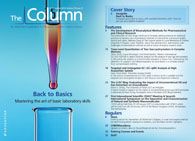Targeted and Untargeted GCxGC–qMS Analysis at High Acquisition Speeds
In this article comprehensive GCxGC–qMS is shown to be a suitable tool for targeted and untargeted analysis in the flavours and fragrances industry.
Comprehensive two-dimensional gas chromatography coupled to mass spectrometry (GC×GC–MS) and two-dimensional liquid chromatography coupled to MS (LC×LC–MS) are chromatographic hyphenation methods that provide extremely large peak capacities. In the flavours and fragrances industries, as well as in other industries, a product with a defined composition is used as a reference for production. As the manufactured products may differ slightly from the ideal, it is important to confirm (a) if a product has the composition needed, (b) if an unwanted compound is present, and (c) clarify if production steps need to be reviewed.
There have been some interesting publications1–5 illustrating the benefits of quadrupole gas chromatography mass spectrometry (GC–MS) with high-speed data acquisition for comprehensive GC×GC–MS.

Photo Credit: Jordan Lye/Getty Images
Tranchida et al.2 reported the use of triple quadrupole with GC×GC–MS–MS and fast scan/MRM (multiple reaction monitoring) switching for untargeted and targeted analysis in one run in food analysis.
In another application the quantitative determination of polychlorinated biphenyls (PCBs) in environmental samples using GC×GC–MS–MS with high-speed MRM switching was highlighted.3
Quantitative precision studies using a high-speed MS detector have also been reported,4 and extensive comparison of linearity of calibration curves compared to time-of-flight (TOF) methods has been described by Tsugawa et al.5
In comprehensive GC×GC, an orthogonal set of columns is commonly used; that is, a column with a non-polar phase is connected to a polar phase or vice versa. For the analysis of samples containing high boiling compounds like diesel fuel, a mid-polar column is often used in the 2nd dimension. This approach is applied here as well. Another benefit of a mid-polar column is that is shows less bleeding background than a wax phase.
In this article we examine the benefits of comprehensive GC×GC–qMS in fragrance analysis.
Method
Instrumentation: For the GC×GC–qMS measurements discussed in this article, the single quadrupole GCMS-QP2010 Ultra (Shimadzu) was used. For comprehensive data handling, ChromSquare V2 software (Shimadzu) was applied. A 30 m × 0.25 mm, 0.25-μm RTX-1 column (Restek) was coupled to a 1 m × 0.1 mm, 0.1-μm BPX50 column (SGE). A two-stage thermal modulation was performed by using the ZOEX I cryomodulator (Zoex corp.)
Method Parameters: In Figure 1, the contour plot of a fragrance oil is shown (scan 60–370 amu, 50 Hz). The modulation period was set to 8 s. The GC programme was 40 °C, 0.1 min; then 2.5 °C/min to 250 °C. The head pressure was kept constant at 150 kPa. The signals were integrated, and the blobs were assembled from measured peaks based on both modulation frequency and spectra of each modulated peak. The software allowed various ways of averaging spectra over the peaks with subsequent baseline subtraction.

Figure 1: Contour plot of a perfume oil.
Discussion
A good example of the benefits of using GC×GC–qMS is illustrated in Figure 2, which shows a blob of lavandulyl acetate. The top part shows the correlation of the measured peaks with the 2D plot interpretation. The centre of the peak for one modulation is indicated in the figure. The intensity of each scan is represented by a colour scale. As a result, each peak has a coloured area in the contour plot where the vertical width is defined by the peak width, and the horizontal width is defined by the modulation frequency.

Figure 2: Blob of lavandulyl acetate without (top) and with graphical interpolation.
The graphical interpolation is indicated in the insert of Figure 2. To demonstrate the spectra quality at high speeds, Figure 3 shows one modulated peak relative to gamma terpinene together with three spectra over the peak (rise, top, and descend). The similarity index is larger than 90 in all cases.

Figure 3: Modulated peak of gamma terpinenes with spectra at peak rise, top, and descent.
To define target compounds, the data set is integrated with a subsequent library search. Subsequently, only the blobs of interest are selected and added to the software method file. Using this operation, the compound and the baseline corrected spectrum together with the two-dimensional retention times and linear retention indices (option) is stored within the method.
After the method has been created using this procedure, it can be applied to process a series of samples. The spectra and retention times of the targets stored in the method are compared to the relevant blobs in the samples. Two criteria have to be fulfilled:
1. The retention times should be within a specified limit
2. The spectra of the target blobs in the sample are compared to the one stored in the method and must be larger than a given similarity index.
All blobs in a sample are integrated, therefore the unidentified blobs are specified to be unknown. A subsequent library search can be performed for the entire resulting peak table, and the unknowns can be potentially identified according to the library used while the identification of the targets remains unchanged. In addition, a linear retention index can be used. The resulting peak table contains the method related blobs (targeted blobs) as well as untargeted blobs, which are identified by the library search process. As an example, a section of the peak table is shown in Table 1. Names in black are targets; the ones in red are untargeted identified blobs.

Table 1: List of targets and unknown blobs identified by library search.
Conclusion
Comprehensive GC×GC–qMS was shown to be a suitable tool for targeted and untargeted analysis in the flavours and fragrances industry. A statistical tool allows the comparison of concentrations of the targets in different samples. This approach can be adapted to other application fields.
References
1. G. Purcaro et al., Analytical Chemistry 82(20), 8583–8590 (2010).
2. P. Q. Tranchida, F. A. Franchina, M. Zoccali, S. Pantò, D. Sciarrone, P. Dugo, and L. Mondello, Journal of Chromatography A 1278, 153– 159 (2013).
3. Kitano et al., Poster 0008, Dioxin, Barcelona Spain, 2013.
4. H.-U. Baier and O. Schmitz, The Column 8(19) 9–13 (2012).
5. Tsugawa et al., J. Biosci. Bioeng. 12(3), 292–8 (2011).
Dr. Hans-Ulrich Baier studied physics and achieved his PhD degree in 1991. He has been working for Shimadzu Europa GmbH since 1992. He started as a product specialist for surface analysis and mass spectrometry. From 1996, he was a product specialist for GC and GC–MS.
E-mail: shimadzu@shimadzu.eu
Website: www.shimadzu.eu
This article is from The Column. The full issue can be found here:http://images2.advanstar.com/PixelMags/lctc/digitaledition/November20-2014-uk.html

Analysis of Pesticides in Foods Using GC–MS/MS: An Interview with José Fernando Huertas-Pérez
December 16th 2024In this LCGC International interview with José Fernando Huertas-Pérez who is a specialist in chemical contaminants analytics and mitigation at the Nestlé Institute for Food Safety and Analytical Sciences at Nestlé Research in Switzerland, In this interview we discuss his recent research work published in Food Chemistry on the subject of a method for quantifying multi-residue pesticides in food matrices using gas chromatography–tandem mass spectrometry (GC–MS/MS) (1).
The Use of SPME and GC×GC in Food Analysis: An Interview with Giorgia Purcaro
December 16th 2024LCGC International sat down with Giorgia Purcaro of the University of Liege to discuss the impact that solid-phase microextraction (SPME) and comprehensive multidimensional gas chromatography (GC×GC) is having on food analysis.

.png&w=3840&q=75)

.png&w=3840&q=75)



.png&w=3840&q=75)



.png&w=3840&q=75)










